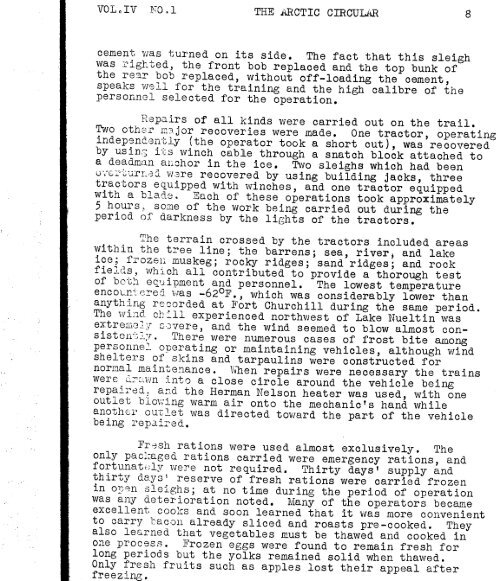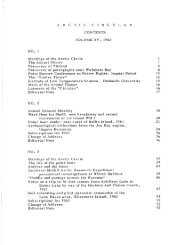Volume 4, 1951 - The Arctic Circle - Home
Volume 4, 1951 - The Arctic Circle - Home
Volume 4, 1951 - The Arctic Circle - Home
Create successful ePaper yourself
Turn your PDF publications into a flip-book with our unique Google optimized e-Paper software.
cement was turned on its side. <strong>The</strong> fact that this sleigh<br />
was righted, the front bob replaced and the top bunk of<br />
the re~r bob replaced, without off-loading the cement,<br />
speaks weIl for the training and the high calibre of the<br />
personnol selected for the operation.<br />
Repairs of aIl kinds were carried out on the trail.<br />
Two oth8:r ill3,jorrecoveries were made. One tractor, operating<br />
indepenaently (the operator took a short eut), was recovered<br />
by usin::;its winch cable through a snatch block attached to<br />
a deadman anchor in the ice. Two sleighs which had been<br />
Ü\"c:::-·LurLaèl W3re recovered by using building jacks, three<br />
tractors equipped wi th vvinches, and one tractor equipped<br />
with a blade. Each of these operations took approximately<br />
5 hours! sorne of the work being carried out during the<br />
period of darkness by the lights of the tractors.<br />
<strong>The</strong> terrain crossed by the tractors included areas<br />
within the tree line; the barrens; sea, river, and lake<br />
lce; f:rozen muskeg; rocky ridges; sand ridges; and rock<br />
fields, which aIl contributed to provide a thorough test<br />
of bC"0l1equ.ipment and personnel. <strong>The</strong> lowest tempera ture<br />
encO"l_"n.-'~ ere d 'Vvas-62oF., which was considera bly lower than<br />
anything recorded at Fort Churchill during the same periode<br />
<strong>The</strong> wincl ob::"llexperienced north'west of Lake Nueltin was<br />
extremrJJ.yG3Vere, and the wind seemed to blow almost consisten".;}.:".<strong>The</strong>re<br />
were numerous cases of frost bite among<br />
personne~ operating or maintaining vehicles, although wind<br />
shelters of skins and tarpaulins were constructed for<br />
normal maintenance. Villenrepairs were necessary the trains<br />
were L~:""::~vminto a close circle around the vehicle being<br />
repai}~ed: and the Herman Nelson heater was used, wi th one<br />
outlet blo~ing warm air enta the mechanic's hand while<br />
anothE.:l' out,let was directed toward the part of the vehicle<br />
being repair·ed.<br />
Fresh rations were used almost exclusively. <strong>The</strong><br />
only pacl;:agedrations carried were emergency rations, and<br />
fortunately were not required. Thirty days' supply and<br />
thirty days\ reserve of fresh rations were carried frozen<br />
in o~en sleighs; at no time during the period of operation<br />
was any deterioration noted. Many of the operators became<br />
excellent cooks and soon learned that it was more convenient<br />
to carry bac.:m already slieed and roasts pre -eooked. <strong>The</strong>y<br />
also le&rned that vegetables must be thawed and eooked in<br />
one prooess. Frozen eggs were found to remain fresh for<br />
long periods but the yolks remained solid when thawed.<br />
Gnly fresh fruits sueh as apples lost their appeal after<br />
freezing.












